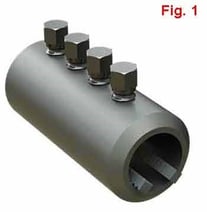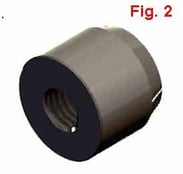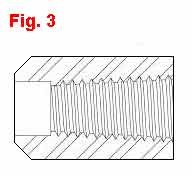Weld-on Rebar Anchors can be specified in several types and styles. In each case, there are advantages and disadvantages. What is important, and of utmost concern to the architect and project engineer, is the strength of the connection between the structural steel and the rebar. The strength is designated by the connect type.
Note: Rebar Anchors are also referred to as Weldable Couplers, Weldable Half Couplers, Taper Lock® Weldable Couplers and Bar Lock® Weldable Couplers.
 Type I
Type I
Type I Rebar connections have a pull out strength of 125% of the yield strength of the rebar. This can be achieved with the basic set screw Rebar Anchor, shown in figure 1. With the set screws turned out, the rebar is inserted to the full depth. The set screws are tightened, which drives the rebar into the serrated edges visible in the lower inside diameter. The pointed tips of the set screws and the 2 rows of serrated ridges form a triangle of contact with the rebar that develops the 125% strength connection required.
The advantage to set screw Rebar Anchors is installation speed and lower cost, compared to Tapered Thread anchors.
A Type II splice can be achieved with a set screw rebar anchor by using the “L” series. These weldable couplers are longer and have 1 or 2 more set screws than the standard length, which increases the connection strength to meet the Type II requirements.
To view the Rebar Anchors and Rebar Couplers catalog, click here.
 Type II
Type II
Type II Rebar connections have a minimum pull out strength of 160% of the yield strength of the rebar. This is achieved by threading the rebar anchor (Fig. 2, inside diameter shows threading) or extending the length as described above.
The Type II connection can be threaded using 2 different methods: A straight UNC thread or a tapered thread.
Straight Thread: The advantage is consistency. Using standard UNC dimensions, any qualified rebar vendor can thread the rods. The disadvantage of a straight thread is that it is time consuming to install. To achieve the full strength, the rebar must be threaded until it bottoms out. This can require multiple revolutions of the rebar.
 Tapered Thread: The advantage here is installation speed. The taper on the thread is angled more steeply than a pipe thread. The angle is sharp enough that the rebar will insert deep into the coupler before stopping. (Fig. 3) Then, only a few turns will have it bottomed out. While it seems counter intuitive, the connection is as strong as a straight thread because all threads are making full contact. The disadvantages with tapered threads are higher cost than straight threads and inconsistent thread specifications.
Tapered Thread: The advantage here is installation speed. The taper on the thread is angled more steeply than a pipe thread. The angle is sharp enough that the rebar will insert deep into the coupler before stopping. (Fig. 3) Then, only a few turns will have it bottomed out. While it seems counter intuitive, the connection is as strong as a straight thread because all threads are making full contact. The disadvantages with tapered threads are higher cost than straight threads and inconsistent thread specifications.
“Inconsistent” means each manufacturer uses their own tapered thread dimensions. So, when using tapered thread anchors it is very important that the rebar anchor and threaded rebar both be supplied by the same company. This can create coordination problems between the various trades involved, but it is important with tapered threads to remain consistent.





